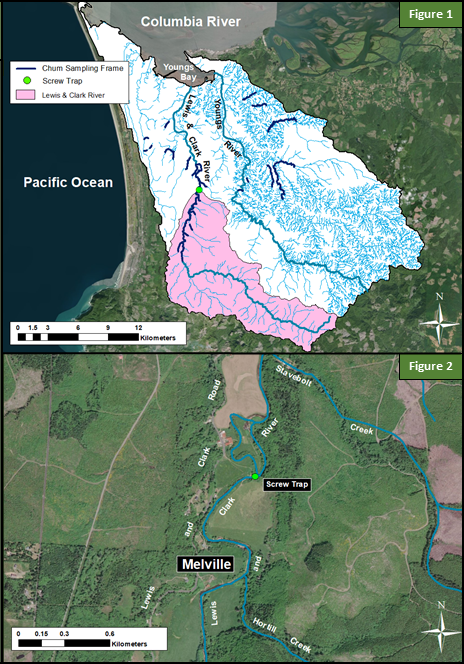Lewis and Clark River (Juvenile Monitoring)

Youngs Bay Population
Lewis and Clark River
The Lewis and Clark River is a tributary of Youngs Bay, entering the southern portion of the bay southwest of Youngs River (Figure 1). No hatchery releases occur in Lewis and Clark River, but spawning of wild and hatchery Chinook Salmon, Coho Salmon, and Steelhead are known to occur in the basin. Historically, the Lewis and Clark River may have supported up to 4,000 adult Chum Salmon spawners (based on habitat area-spawner density expansions from data in Fulton 1970 and ODFW spawning surveys). However, in recent years only a small number of Chum Salmon have been observed on spawning surveys conducted in the basin. The Lewis and Clark River contains 78 km of low gradient habitat in mainstem and tributary reaches (Bischoff et al. 2000a), with significant restoration potential that could provide high quality spawning habitat for Chum Salmon (Alfonse et al. 2017b). In 2017, a rotary screw trap was installed between Stavebolt and Hartill Creeks, approximately 1 km downstream of Melville (Figure 2). The trap was operated between March 2nd and June 14th.
Literature Cited
Alfonse, B., K. Homel, J. E. Nunnally, and E. Suring. 2017b. Chum Salmon Spawning Habitat Report for the Youngs Bay and Big Creek Populations. Oregon Department of Fish and Wildlife. Clackamas, Oregon. 134 pages.
Bischoff, J. M., R. B. Raymond, K. U. Snyder, J. Bergeron, and S. K. Binder. 2000a. Youngs Bay Watershed assessment final report. 199 pages.
Fulton, L. A. 1970. Spawning areas and abundance of Steelhead Trout, Coho, Sockeye, and Chum Salmon in the Columbia River basin-past and present. NMFS Special scientific report-Fisheries 618. 37 pages.